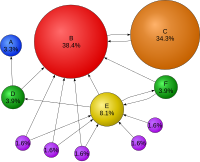
Photo from wikipedia
Hydroxyl radical protein footprinting (HRPF) utilizes hydroxyl radicals to covalently modify solvent exposed regions of proteins. When coupled with mass spectrometry, HRPF can provide insightful information on protein structural changes… Click to show full abstract
Hydroxyl radical protein footprinting (HRPF) utilizes hydroxyl radicals to covalently modify solvent exposed regions of proteins. When coupled with mass spectrometry, HRPF can provide insightful information on protein structural changes including inside cells. However, the complex mixture of proteins and modifications makes identification a complicated task. To search all of the HRPF-induced modification combinations across the full proteome, requires substantial computational power and still can take days to search. To drastically decrease processing time and improve identifications, a novel cloud-based search engine, Bolt, was used to search for HRPF modifications in comparison to a commonly used search engine, Sequest. A 35% increase in the identification of modified peptides was observed in Bolt compared to Sequest with a decrease in computation time. This article is protected by copyright. All rights reserved.
Journal Title: Proteomics
Year Published: 2021
Link to full text (if available)
Share on Social Media: Sign Up to like & get
recommendations!